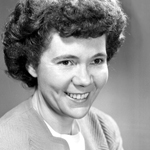Jane Hamilton Hall
After the war she remained at the Los Alamos National Laboratory, where she oversaw the construction and start up of the Clementine nuclear reactor.
[6] Nepotism rules prevented them both working in the same groups together, so while David worked on nuclear reactor design, Hall was assigned to Herbert Parker's Health Physics group, where she soon became head of its Special Studies section.
Parker had her investigate the safety aspects of reactors, and she researched the hazards of inhaling plutonium.
[9] Clementine was the world's first fast reactor, the first to be fueled by plutonium, and the first to use a liquid metal coolant,[6] in this case, mercury.
[6] Hall's research interests included nuclear reactor development, X-ray crystallography and neutron physics, and cosmic rays.
[8] In 1951 she informed Robert Oppenheimer of the results of the Operation Greenhouse George nuclear test, in which the yield of an atomic bomb was "boosted" by the addition of a small capsule containing less than 1 ounce (28 g) of deuterium and tritium, which nonetheless increased the yield by 25 kilotonnes of TNT (100 TJ).
[6][11] In October of that year, the chairman of the AEC, Glenn Seaborg, presented her with the Atomic Energy Commission Citation and gold medal.
